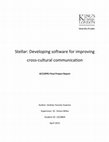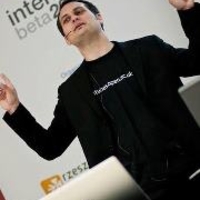Thesis Chapters by Andrey Guenov
This paper includes the appendices to my BSc Computer Science with Management thesis: Stellar: De... more This paper includes the appendices to my BSc Computer Science with Management thesis: Stellar: Developing Software for Improving Cross-Cultural Business Communication

This project carried out theoretical research, development work, and experimentation to explore t... more This project carried out theoretical research, development work, and experimentation to explore the process of developing an application for mobile tablets which facilitates and improves cross-cultural communication within the context of a business conversation. In its complete form, the application will be able to facilitate intercultural communication within meetings, aid in discovering communication inefficiencies within an organization, provide insight into employee conflict, and provide data to allow for more precise team composition by predicting collaboration outcomes from different employee groupings.
In the process of development, the project examined 5 proposed hypotheses detailing different areas of enquiry within the field, with the aim of helping to further the integration of artificial intelligence in the work process of corporations. The project focused on four main functionalities designed to improve communication: modelling conversation, analysing a conversation in a quantifiable way, detecting argumentation schemes, and detecting misunderstanding.
The project carried out an extensive background review of related topics and detailed several important implications of literature to be considered when attempting to apply it to software development. One such discovery made by examining Weigand’s (1999) standard model of misunderstanding was that misunderstanding should be accepted as an integral part of communication. Chat-bot technology and artificial intelligence, primarily pertaining to the theoretical fields of machine learning and natural language understanding, was used to implement the theory behind the project. Upon testing, the final product of the project successfully delivered positive results as measured by the hypotheses and requirements set out in the beginning. Still, limitations remain. Future research directions and possible applications of the produced application are provided.






Uploads
Thesis Chapters by Andrey Guenov
In the process of development, the project examined 5 proposed hypotheses detailing different areas of enquiry within the field, with the aim of helping to further the integration of artificial intelligence in the work process of corporations. The project focused on four main functionalities designed to improve communication: modelling conversation, analysing a conversation in a quantifiable way, detecting argumentation schemes, and detecting misunderstanding.
The project carried out an extensive background review of related topics and detailed several important implications of literature to be considered when attempting to apply it to software development. One such discovery made by examining Weigand’s (1999) standard model of misunderstanding was that misunderstanding should be accepted as an integral part of communication. Chat-bot technology and artificial intelligence, primarily pertaining to the theoretical fields of machine learning and natural language understanding, was used to implement the theory behind the project. Upon testing, the final product of the project successfully delivered positive results as measured by the hypotheses and requirements set out in the beginning. Still, limitations remain. Future research directions and possible applications of the produced application are provided.
In the process of development, the project examined 5 proposed hypotheses detailing different areas of enquiry within the field, with the aim of helping to further the integration of artificial intelligence in the work process of corporations. The project focused on four main functionalities designed to improve communication: modelling conversation, analysing a conversation in a quantifiable way, detecting argumentation schemes, and detecting misunderstanding.
The project carried out an extensive background review of related topics and detailed several important implications of literature to be considered when attempting to apply it to software development. One such discovery made by examining Weigand’s (1999) standard model of misunderstanding was that misunderstanding should be accepted as an integral part of communication. Chat-bot technology and artificial intelligence, primarily pertaining to the theoretical fields of machine learning and natural language understanding, was used to implement the theory behind the project. Upon testing, the final product of the project successfully delivered positive results as measured by the hypotheses and requirements set out in the beginning. Still, limitations remain. Future research directions and possible applications of the produced application are provided.